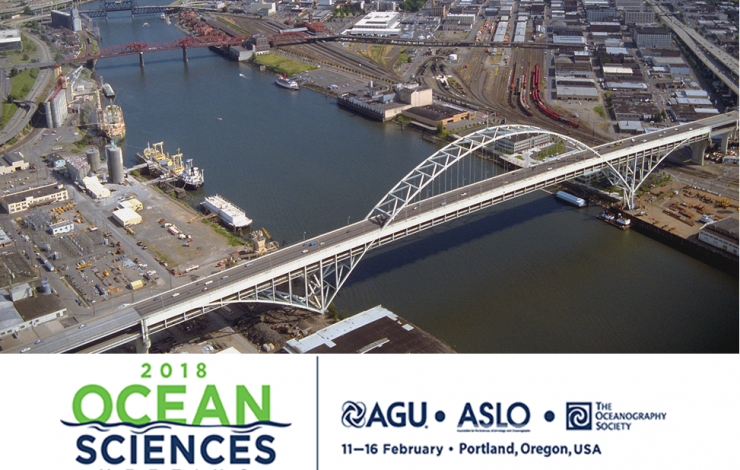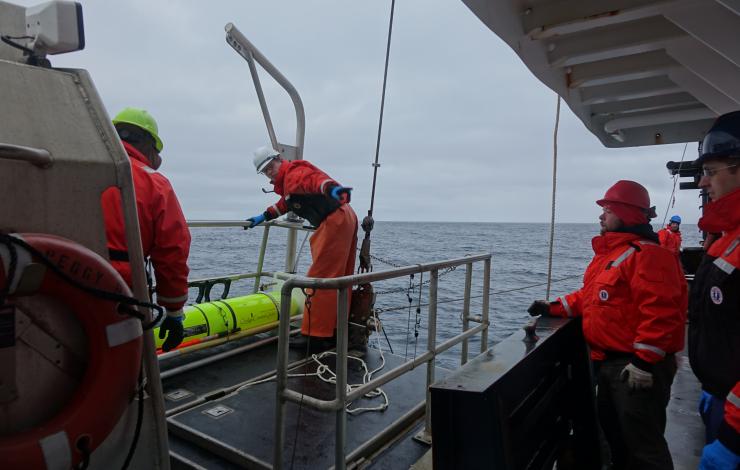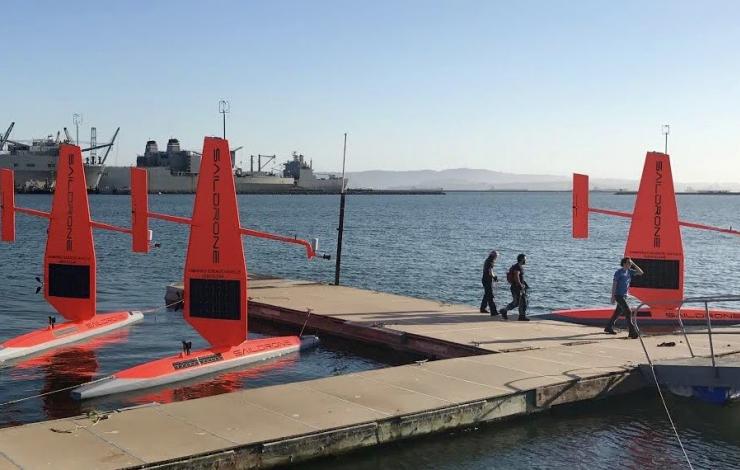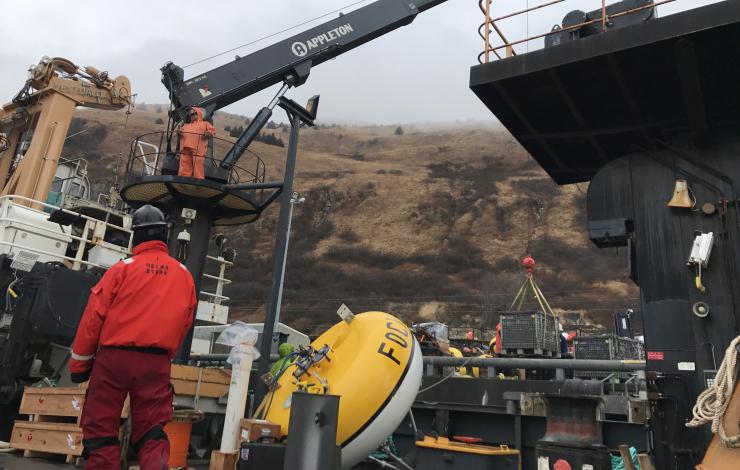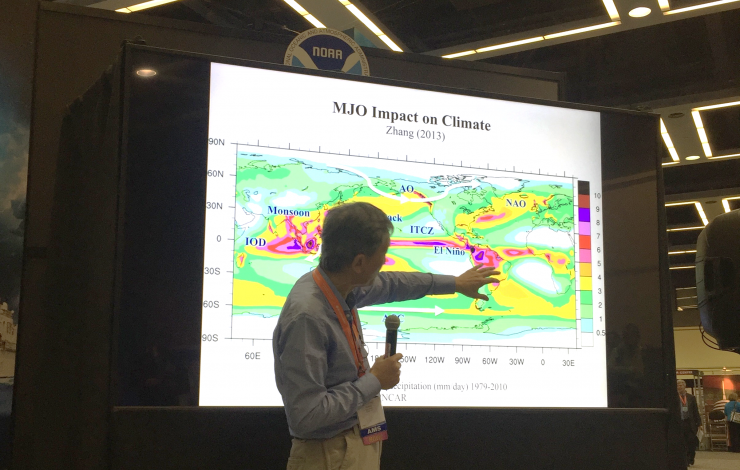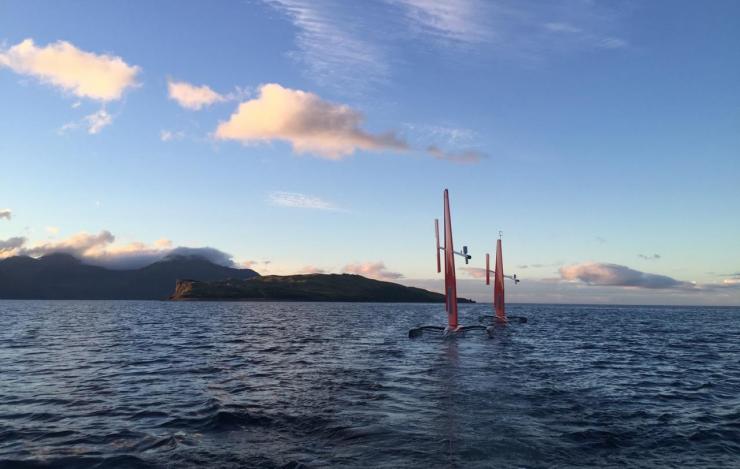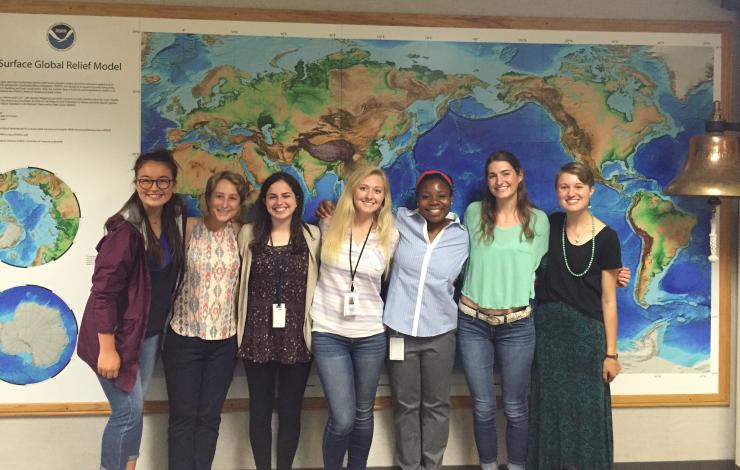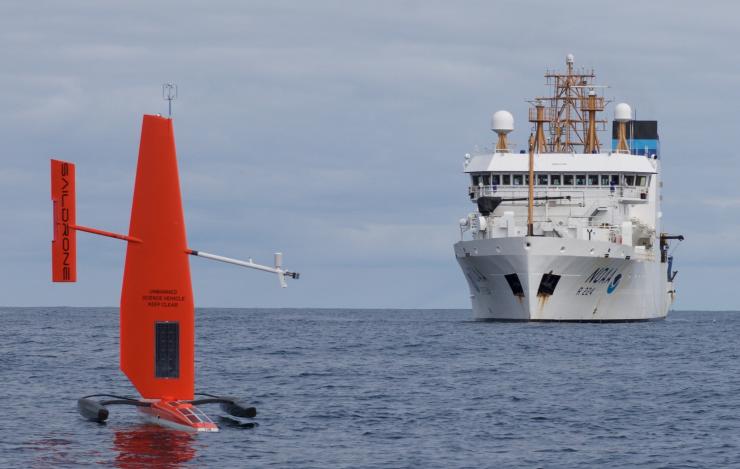You are here
What's New Archive
More than 50 PMEL scientists, including scientists from NOAA, University of Washington's Joint Institute for the Study of the Ocean and Atmosphere (JISAO), Oregon State University's Cooperative Institute for Marine Resources Studies (CIMRS) and the National Research Council, will present a talk or share a poster on their research at the 2018 Ocean Sciences Meeting in Portland, Oregon February 12-16, 2018. PMEL research groups that will be present at the conference are: Acoustics, Arctic, Earth-Ocean Interactions, EcoFOCI, Engineering, Global Tropical Moored Buoy Array, Innovative Technology for Arctic Exploration, Large Scale Ocean Physics, Ocean Carbon, Ocean Climate Stations, Pacific Western Boundary Currents, Science Data Integration Group, Thermal Modeling and Analysis Project
28 talks will present research on ocean carbon, ocean acidification, ocean observing systems, Arctic research including the Distributed Biological Observatory and Arctic Marine Pulses (AMP), ENSO, MJO, hydrothermal vents, Saildrone research, air-sea interactions, SOCCOM, and ocean mixing. 26 posters will be up during the poster sessions and highlight research in the Arctic, hydrothermal vents, acoustics, methane bubbles and hydrates, Saildrone, Oculus Coastal Glider, ocean carbon, deep ocean temperatures, glider research in the Solomon Sea, and ocean acidification and hyopxia.
PMEL staff will also be chairing sessions and workshops on:
- El Nino-Southern Oscillation (ENSO) Diversity, Predictability, and Impacts
- Western Pacific and Indonesian Sea Circulation and Its Environmental and Climatic Impacts
- New Platform and Sensor Technologies: Advancing Research, Readiness, and Transitioning for Sustained Ocean Observing of Essential Ocean Variables
- Methane from the Subsurface Through the Bio-, Hydro-, and Atmosphere: Advances in Natural Hydrate Systems and Methane Seeps in Marine Ecosystems
- Cascadia Margin methane seep and hydrates to share results and coordinate future work
The 2018 Ocean Sciences Meeting is co-sponsored by the American Geophysical Union (AGU), the Association for the Sciences of Limnology and Oceanography (ASLO), and The Oceanography Society (TOS). The meeting is an important venue for scientific exchange across broad marine science disciplines. Sessions will include all aspects of oceanography, especially multidisciplinary topics, as well as presentations that reflect new and emerging research on the global ocean and society, including science education, outreach, and public policy
After 60 days in the Bering Sea, the Oculus Coastal Glider was successfully recovered by crew of the NOAA Ship Oscar Dyson on September 26, 2017. The glider successfully navigated 242.8 nautical miles, completed 3612 dives, and sampled salinity, temperature, dissolved oxygen, sunlight, and fluorescence at a frequency of approximately 3 dives per hour. The glider was tested in a region with a long history of shipboard and mooring observations that provide context for the Oculus glider's observations. Oculus glider measurements reveal detailed information in a known, important biogeographical transition that divides the ecosystems of the northern and southern Bering Sea shelf near St. Matthew Island. Measurements show unexpected ocean mixing in the water column near the island that may be due to internal waves. Data, sensor, and platform analysis is ongoing. Incorporating this higher resolution sampling into the Bering Sea observing network will improve our understanding of how these features affect the ecosystem.
The Oculus is a coastal glider engineered to work in the highly stratified, shallow depths of the Arctic. By using a rapid buoyancy system, the glider can change buoyancy states 20 times faster and achieve speeds three times faster than legacy gliders - allowing for a more efficient and adaptive Arctic survey, but transferable to a variety of markets.
This was the second field test for the Oculus coastal gliders. The first field test occurred early May 2017, also in the Bering Sea, with 387 dives completed near the M2 mooring site. For the second field test, the glider was deployed from the US Coast Gaurd Cutter Healy during the 2017 Arctic Shield mission.
The Oculus was developed at PMEL in partnership with the University of Washington's Joint Institute for the Study of the Atmosphere and Ocean and the University of Washington Seaglider Fabrication Lab.
Over the next four months, NOAA scientists will launch unmanned ocean vehicles, called Saildrones, from the Arctic to the tropical Pacific Ocean to help better understand how changes in the ocean are affecting weather, climate, fisheries and marine mammals. The wind and solar-powered research vehicles that resemble a sailboat will travel thousands of miles across the ocean, reaching some areas never before surveyed with such specialized technology.
Earlier this week, PMEL scientists and Saildrone, Inc. sent off three saildrones from Dutch Harbor, Alaska. For the first time, two saildrones will sail north through the Bering Strait into the Arctic Ocean to study how the Arctic Ocean is absorbing carbon dioxide. A third unmanned vehicle will survey more than 3,100 nautical miles in the Bering Sea for walleye pollock, Northern fur seals that prey on them and the elusive North Pacific right whale. This work will build on research conducted during 2016, including a study of fur seal feeding rates. NOAA Fisheries Alaska Fisheries Science Center scientists will also attach video cameras to fur seals to record feeding and verify the species and sizes of fish that fur seals are eating.
In September, scientists will launch two more unmanned systems from Alameda, Calif., on a six-month, 8,000-nautical-mile, round-trip mission to the equator to improve the Tropical Pacific Observing System (TPOS). TPOS provides real-time data used by the U.S. and partner nations to forecast weather and climate, including El Nino. The unmanned sailing vehicles will take part in a larger field study with NASA, and visit mooring sites along the array of observing buoys.
Read the release on NOAA Research here and follow along with the Innovative Technology for Arctic Exploration's Blog for the Bering and Chukchi Seas missions.
May 16-June 2: The second summer field season for the Arctic Heat Open Science Experiment began with its first flight out of Kotzebue, Alaska. The research team, including Kevin Wood, are flying aboard a specially-outfitted NOAA Twin Otter aircraft to launch traditional atmospheric and oceanographic probes as well as the experimental Air-Launched Autonomous Micro-Observer (ALAMO) floats into the Chukchi Sea. After last year's field missions, two ALAMO floats made it through the winter and are currently profiling every 5 days. Check out the raw data for float 9085 and float 9076.
Arctic Heat is an open science experiment, publishing data generated by the project to further NOAA Science Missions with real-time data to facilitate timely observations for use in weather and sea-ice forecasts, to make data readily accessible for model and reanalysis assimilation, and to support ongoing research activities across disciplines.
Arctic Heat is a joint effort of NOAA Pacific Marine Environmental Laboratory (PMEL) Arctic Research, the Innovative Technology for Arctic Exploration (ITAE) program, the ALAMO development group at the Woods Hole Oceanographic Institution (WHOI), and the Joint Institute for the Study of the Atmosphere and Ocean (JISAO) at the University of Washington.
The EcoFOCI spring mooring cruise departed on Earth Day, April 22, from Kodiak, AK to service a biophysical mooring array in the Bering Sea, including M2. This is one of 11 research cruises the program will participate in from March-October. Aboard the NOAA research ship Oscar Dyson, scientists from PMEL, JISAO and AFSC are in Alaskan waters to retrieve and redeploy moorings, collect CTD (conductivity-temperature-depth) and other data. Peter Proctor from PMEL/JISAO is the Chief Scientist on the cruise and Geoff Lebon is the lead mooring scientist. The M2 mooring has been deployed in the southeastern Bering Sea for over 20 years and has been providing year-round measurements of temperature, salinity, nitrite, chlorophyll, and currents in this highly productive area. Long-term time-series at this site are a critical tool for adapting to climate change and guiding sustainable management of living resources in the Bering Sea.
EcoFOCI will also be field testing and using several technologies in collaboration with PMEL’s Innovative Technology for Arctic Exploration program; including the Prawler, Oculus and Acrobat Towed Vehicle. These technologies enhance shipboard and mooring research with more data collection over a fine scale region.
The EcoFOCI program is a collaborative research effort by scientists at the Pacific Marine Environmental Lab (PMEL) and Alaska Fisheries Science Center (AFSC) focusing on the unique and economically important high-latitude ecosystems of Alaska. Learn more about the program here.
Last week, PMEL scientists attended the American Meteorological Society (AMS)’s Annual Meeting in Seattle, WA and the Alaska Marine Science Symposium (AMSS) in Anchorage, AK. Presentations covered research in the Bering Sea, data management and access, El Nino, sea ice, the Earth's energy imbalance, innovative technologies, and recent warming in the Pacific and others.
At AMSS, the Ecosystems and Fisheries-Oceanography Coordinated Investigations (EcoFOCI) group had multiple presentations and posters on the Bering Sea including topics on the recent marine heat wave in Alaska, linking annual oceanographic processes to contiguous ecological domains in the pacific Arctic, fish distributions, ecology, Saildrone and oceanography.
A wider range of topics were covered at AMS and included invited talks from Nick Bond, Chidong Zhang and Kevin Wood. Dr. Zhang spoke about the Dynamics of the Madden-Julian Oscillation; Kevin Wood presented the Old Weather Project using historical U.S. ship logbooks to collect and analyze historical climate data; and Nick Bond discussed the recent warming in the NE Pacific. The annual meeting is the world’s largest yearly gathering for the weather, water, and climate community and brings together atmospheric scientists, professionals, students, educators and research’s from around the world. AMS is the nation’s premier scientific and professional organization promoting and disseminating information about the atmospheric, oceanic, hydrologic sciences.
Learn more about all our different research themes and groups here.
On September 3, after three months of collecting data in the Bering Sea, the two Saildrones have been safely recovered. The Saildrones each traveled almost 3000 nautical miles in 101 days. After arriving in Dutch Harbor, AK, the Saildrones were packed into a container and shipped to their home base in San Francisco, CA. Data from the tested technologies for fish and marine mammal acoustics are expected mid-September with preliminary analysis completed around the New Year.
This was a collaborative mission between the Pacific Marine Environmental Lab, Alaska Fisheries Science Center, Saildrone, Inc., Simrad AS/Kongsberg Maritime, Greeneridge Sciences, Inc, and Wildlife Computers.
Continue to follow the Saildrone on the Innovative Technology for Arctic Exploration page to learn more about upcoming events and preliminary results in the weeks and months to come.
This summer, NOAA’s Pacific Marine Environmental Lab is mentoring six undergraduate Hollings scholars and one NSF research experience for undergraduates (REU) student. These students come from all over the United States and all have a passion for the marine environment. The summer internships provide each student with hands-on research experience as they work closely with a mentor. This year, the undergraduates are placed in the Acoustics, Arctic, Carbon, Ocean Climate Stations, Atmospheric Chemistry and Large Scale Ocean Physics groups and are located in Seattle, WA and Newport, OR.
We are very excited to have this year’s cohort: Abigail Birnbaum, Leah Chomiak, Allison Hogikyan, Gabriella Kalbach, Cordelia Sanborn-Marsh, Meghan Shea, and Audrey Taylor. Read more about each Hollings Scholar and our NSF-REU student on our education page.
Learn more about NOAA’s Ernest F. Hollings (Hollings) Undergraduate Program and the National Science Foundation Research Experience for Undergraduate (NSF-REU) program.
In April, PMEL and JISAO scientists and engineers teamed up with Saildrone, Inc. to test two Saildrones in the harsh environment of the Bering Sea for the first time. The unmanned instruments sailed from Dutch Harbor, AK on April 22. They have traveled over 2,000 miles each since then, taking over 40 million measurements as they sail north following the ice retreat. With the Arctic environment changing rapidly, the success of these vehicles couldn’t come at a better time. The measurements taken across the eastern Bering Sea have the potential to provide a comprehensive picture of the changes that occur in the late spring environment when the ice is retreating.
Read more about this research on the NOAA Research page and the Innovative Technology for Arctic Exploration site.
